How To Clear Disk Space In Windows 10
Summary :
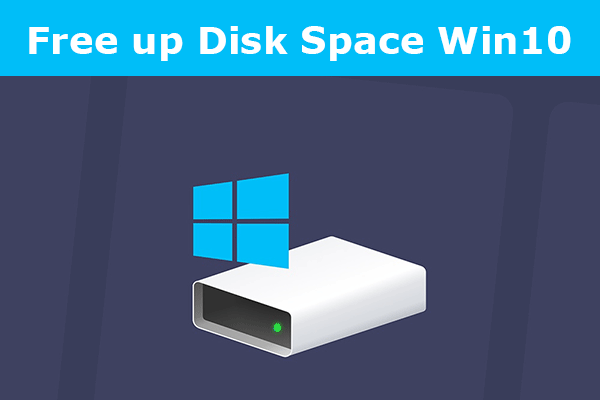
Receiving "There is not enough free space on partition (C:)" error? C drive keeps filling up? We show you some fixes tofree up disk space as well as how to use free partition manager to upgrade hard drive in Windows 10.
Quick Navigation :
- What Is Taking up Space on My Hard Drive
- Fix #1: Delete Unnecessary Files
- Fix #2: Uninstall Apps You No Longer Need
- Fix #3: Run Disk Cleanup
- Fix #4: Disable Hibernation Mode
- Fix #5: Enable Compact OS
- Fix #6: Reduce the Size of WinSxS Folder
- Fix #7: Turn on OneDrive Files On-Demand
- Fix #8: Move Files to another Location
- Fix #9: Save New Files to another Location
- Fix #10: Get a Larger Hard Drive
- Now, It's Your Turn
- User Comments
What Is Taking up Space on My Hard Drive
In the daily usage of computer, you may find hard drive space disappearing and wonder "what is taking up space on my hard drive?" Indeed, it is hard to tell what is taking up disk space simply by looking at installed apps and saved files in Windows Explorer. Luckily, Windows helps you make it out.
Go to Settings -> System -> Storage, you will see all drives listed there. You can select a drive to see what's taking up space.
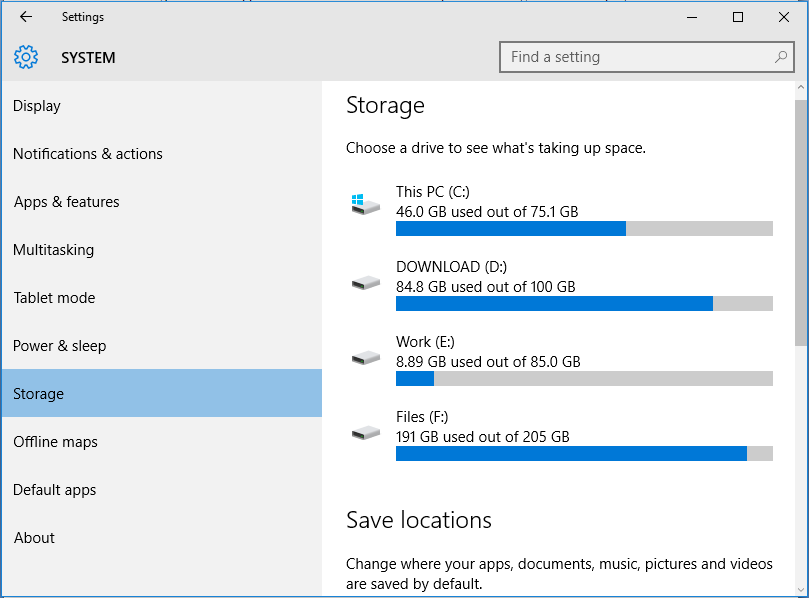
Besides, you can even click each item to go deeper. For instance, you will be able to see how much disk space an app/game takes.
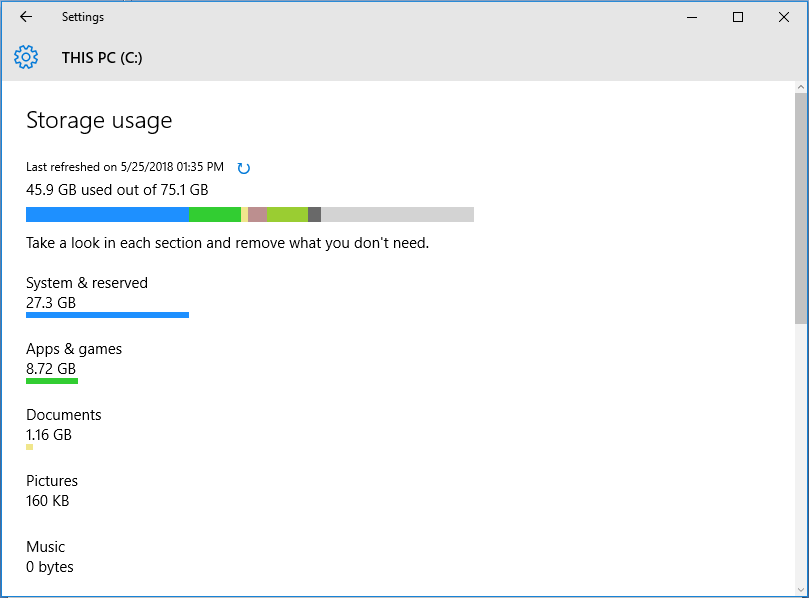
Right now, we show you how to clean hard drive in multiple solutions.
Fix #1: Delete Unnecessary Files
Here are two approaches for you to do this. The first one is to select and delete some files you no longer use manually. The second one is to make use of Storage Sense. Storage Sense was introduced in Windows 10 version 1703 to get rid of temporary files and stuff in your Recycle Bin. If you have Storage Sense turned on in Settings, Windows can automatically free disk space by removing files you don't need.
If your Storage Sense is still OFF, you can now make it work.
Step 1. Go to Start menu -> Settings -> System -> Storage. Toggle the option for "Storage Sense" ON and click the option "Change how we free up space".
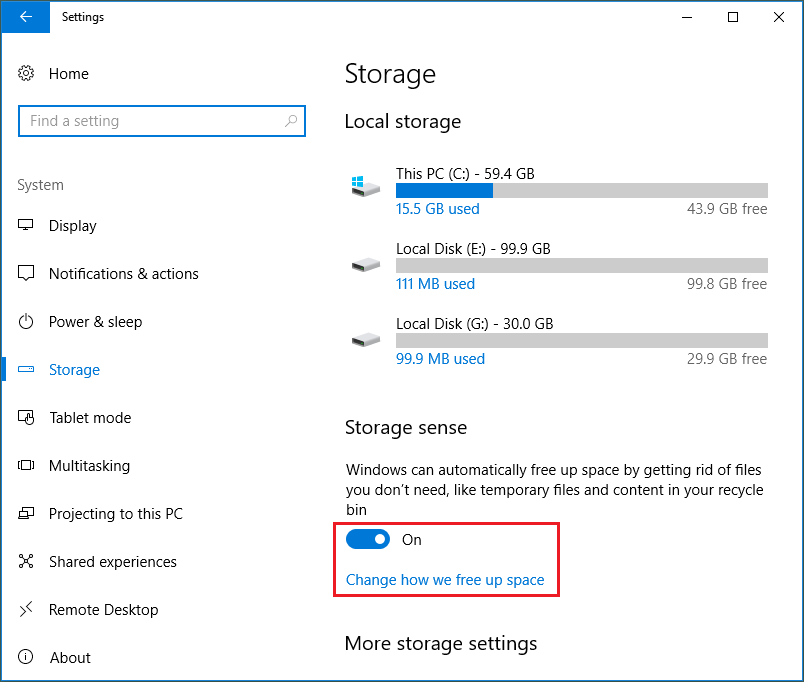
Step 2. In the next window, check what kind of temporary files to delete. You can also press "Clean now" to free up disk space Windows 10 now.
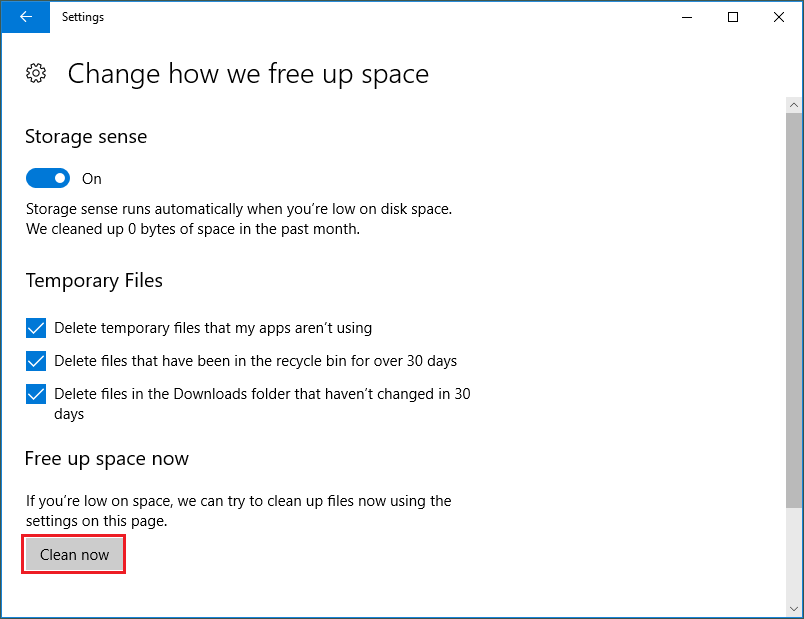
Fix #2: Uninstall Apps You No Longer Need
If you have some programs installed for problem-solving and now they are no longer needed, you can go ahead and uninstall them to free up disk space. To do this, right-click Windows Start menu and click "Programs and Features". Then right click the program you no longer need and choose "Uninstall". Repeat this process to remove the rest unnecessary apps.
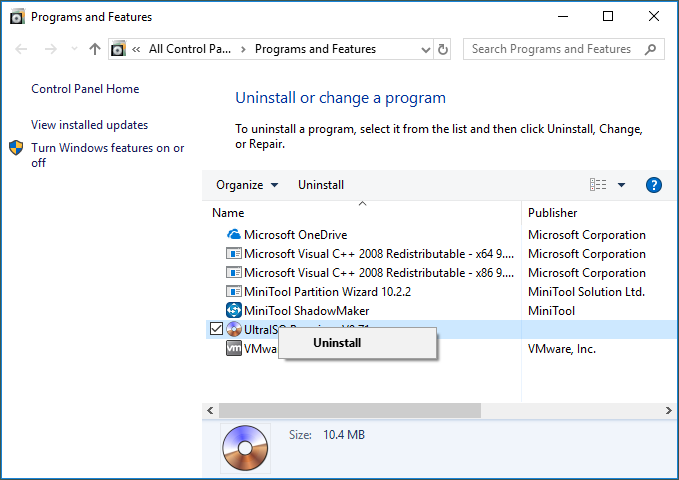
Fix #3: Run Disk Cleanup
Disk Cleanup is a built-in tool that deletes temporary and unimportant files. When your hard drive like C drive keeps filling up, you can go ahead and use Disk Cleanup to free disk space. Simple guide is shown below:
Step 1. Go to Explorer and navigate to "This PC". Then right-click the drive you want to clean up and choose "Disk Cleanup" from the best match.
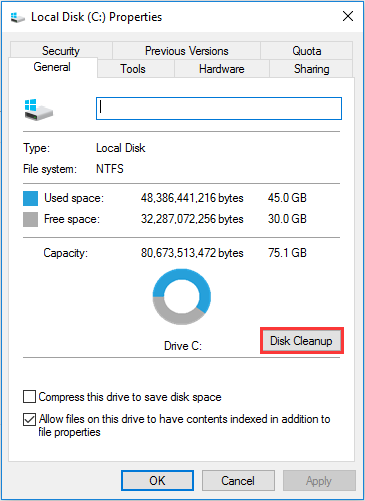
Step 2. After several minutes' calculation, you will be given a new interface listing files in total that can be cleaned as well as the file size taken by each file type. At this time, check the ones you don't want and click OK.
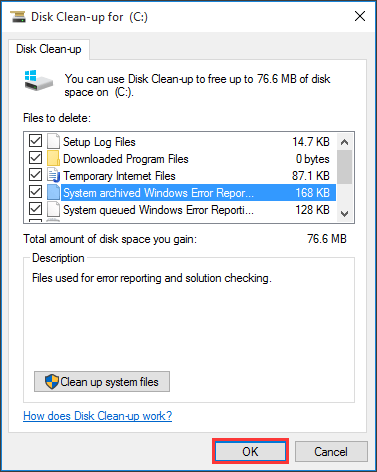
Tip: If you are freeing up disk space from the C drive, you can read Disk Cleanup Windows 10 to remove more system files such as the System Restore and Shadow Copies.
Fix #4: Disable Hibernation Mode
Hibernation in computing is to power down a computer while maintaining its state. If you have enabled Hibernation Mode in Windows, by changing the Folder Options to "Show hidden files, folders and drives" and unchecking "Hide protected operating system files (Recommended)", you will find a file named "hiberfil.sys" located in the C drive, taking several gigabytes' storage space.
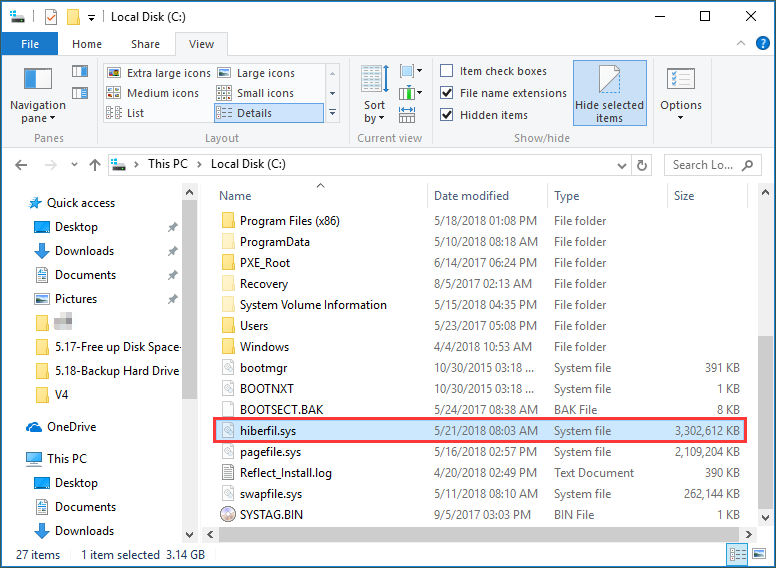
To free up disk space taken by this file, you can open CMD and run this command:
Powercfg /hibernate off

By doing this, the "hiberfil.sys" is deleted totally.
Fix #5: Enable Compact OS
Compact OS is introduced with Windows 10. It decreases the operating system's size using the combination of compression and software tricks. It also reduces the footprint of Windows apps to free up disk space, making sense in Windows disk cleanup.
Enabling Compact OS is easy. However, since you are handling the operating system, it is significant to create a system image backup before you proceed.
Step 1. Search for Command Prompt and run it as Administrator.
Step 2. Type the following command to compress Windows 10 and applications and press Enter:
Compact.exe /CompactOS:always
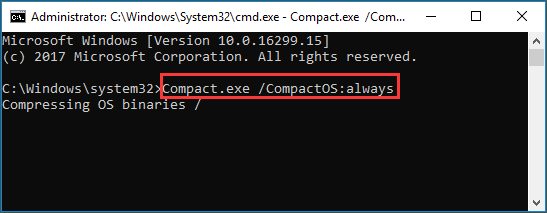
Step 3. This process will take around 20 minutes. When it finishes, you get 2GB around disk space.
Tip: At any time you want to revert, you can run the contrary command instead: Compact.exe /CompactOS:never
Fix #6: Reduce the Size of WinSxS Folder
If your C drive keeps filling up, you can go to C:\Windows to find a folder named "WinSxS". By viewing its properties, you will see it takes quite a lot of disk space (image attached).
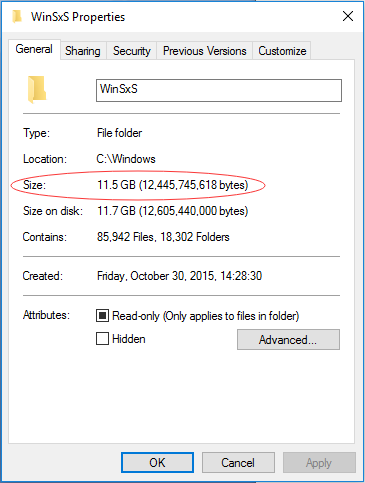
The WinSXS folder contains all Windows system components and continues to grow with the time Windows installed. It also builds up unnecessary files like old versions of system components over time.
Now you may ask:
"Can we remove WinSxS folder for Windows disk cleanup?"
Note that you should not delete the entire WinSxS folder or delete some files from it, as this might severely damage your system, making your PC impossible to restart or update. However, you can do the followings to remove the unnecessary files.
Step 1. Go to Control Panel.
Step 2. Set to view by Category and select "System and Security".
Step 3. Select "Schedule tasks" under Administrative Tools.
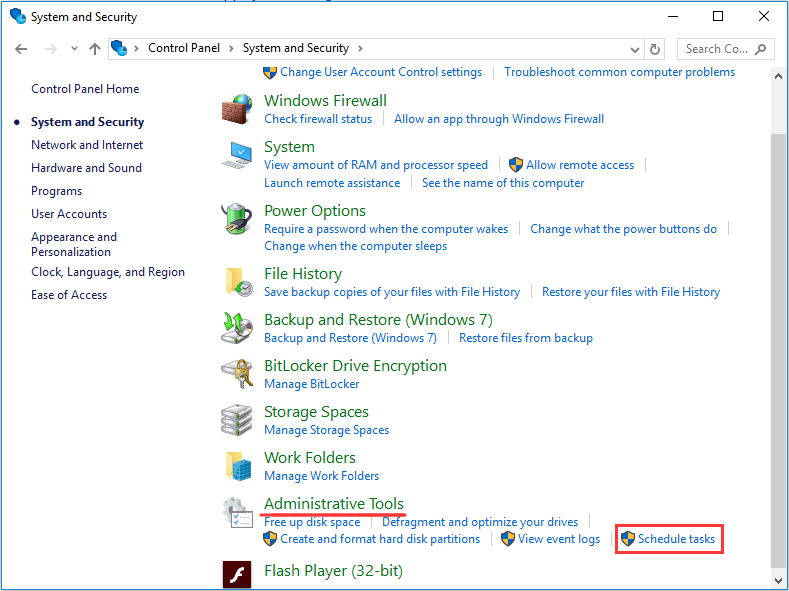
Step 4. In the left panel, select Task Scheduler Library -> Microsoft -> Windows -> Servicing.
Step 5. In the middle panel, right-click "StartComponentCleanup" and choose "Run".
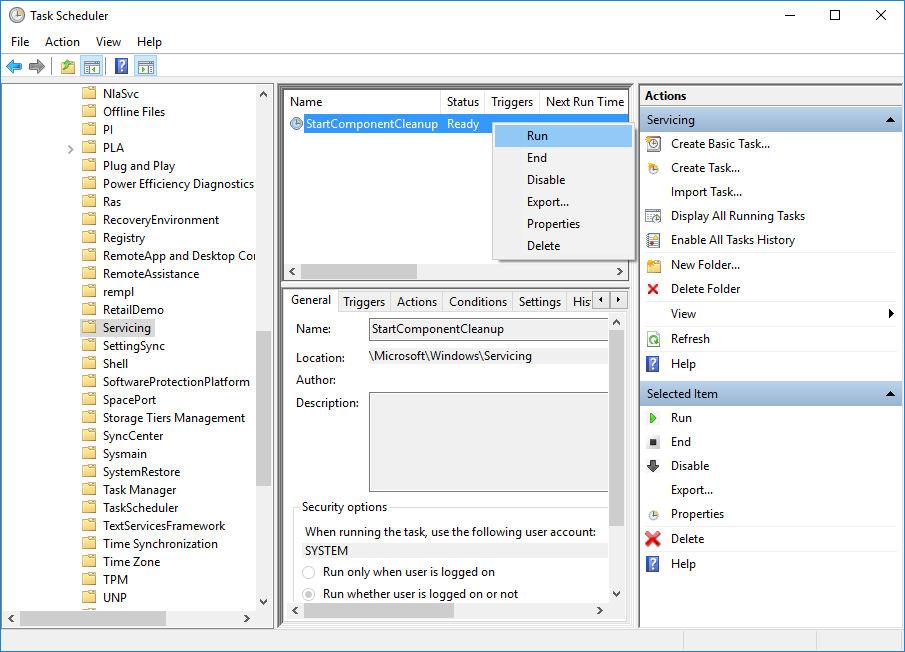
After the above trying, if your hard drive space keeps disappearing, you may consider the rest workarounds.
Fix #7: Turn on OneDrive Files On-Demand
If your PC is running Windows 10 Fall Creators Update and higher version, you can free up disk space by turning on OneDrive Files On-Demand. With this feature enabled, you'll be able to get to your OneDrive files from your PC without having to download them all, thus, freeing up a lot of disk space.
Step 1. Click the OneDrive icon on the taskbar and log into your account.
Step 2. Right click the OneDrive icon and choose "Settings".
Step 3. Navigate to "Settings" tab and make sure the option "Save space and download files as you use them" is CHECKED.
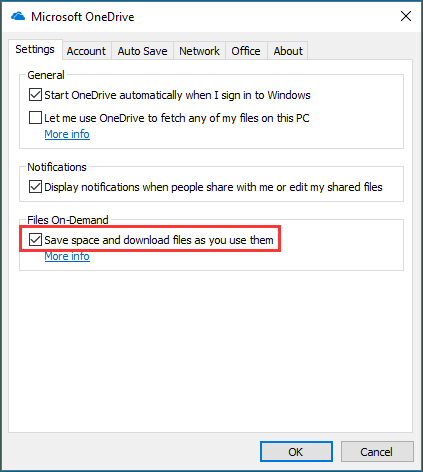
Step 4. Open your OneDrive folder, select all the files and folders, bring up the context menu and choose "Clear space". In this way, all files are kept in the cloud, freeing up disk space Windows.
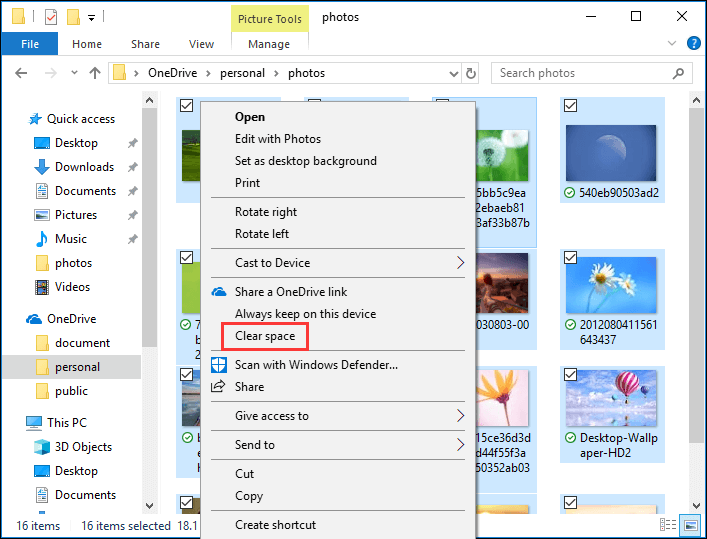
Tip: To free up more space, you can move some personal files from the default folders to your OneDrive folder and then repeat the above process. However, also note that by doing this, you are only able to access these files when there is network connection.
Fix #8: Move Files to another Location
If you have numbers of pictures, audios, videos and other large files saved on the drive, consider moving them to another location such as an external hard drive to free disk space.
Step 1. Open File Explorer, enter each partition and pick up the ones you want to move.
Step 2. After that, go to the Home tab on the ribbon, select Move to and then Choose location.
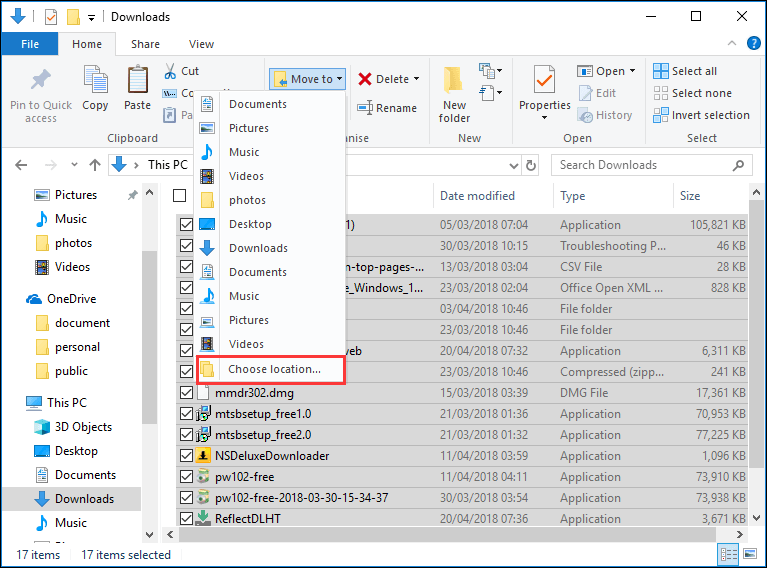
Step 3. Select your external hard drive from the location list and then select Move.
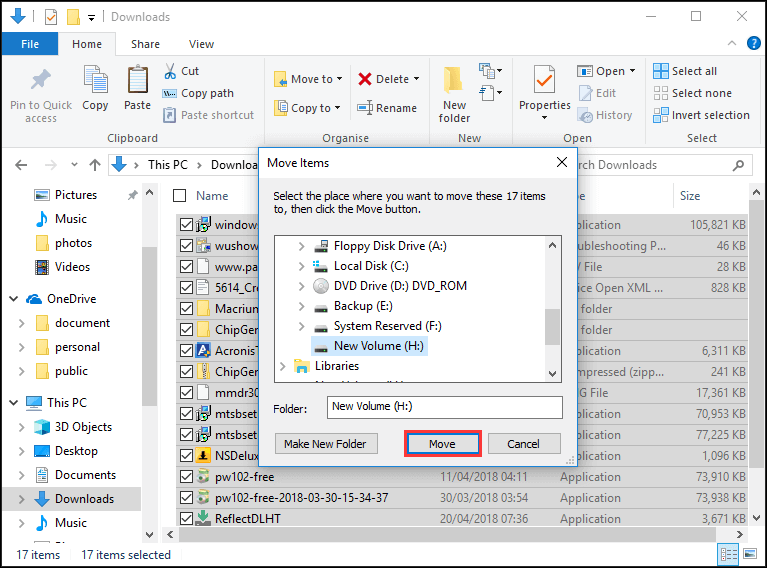
Fix #9: Save New Files to another Location
Instead of saving all your new files to the same location, save some of them to a different drive to free up disk space.
Step 1. Open the Start menu and select Settings -> System -> Storage.
Step 2. Under More storage settings, select "Change where new content is saved".
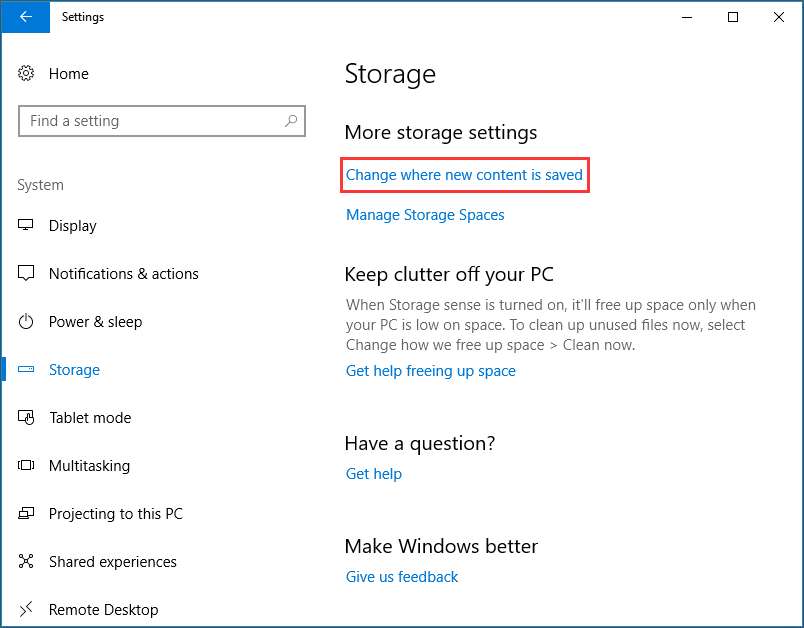
Step 3. For each content type, select a drive to save new files from the drop-down menu.
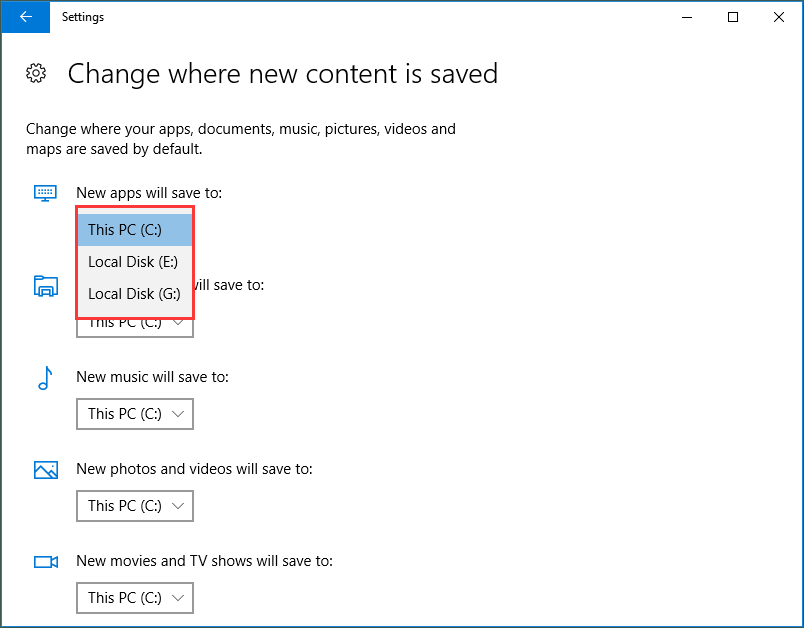
Reading here, we hope you have resolved Windows disk cleanup. But if partition bar gets red from time to time, you still have the last choice…
Fix #10: Get a Larger Hard Drive
Hard drive upgrade is the most effective way to remove "low disk space warning". If you have the budget to purchase a larger hard drive, you can choose any of the following methods. And luckily, MiniTool Partition Wizard can help you all.
Before you start, download and install this free partition manager on computer.
Free Download
Option A: Clone Disk
This way will copy the source disk entirely to the larger one, enabling you to extend each partition size at the same time
Step 1. Select the disk to be copied and choose "Copy Disk" from the action panel.
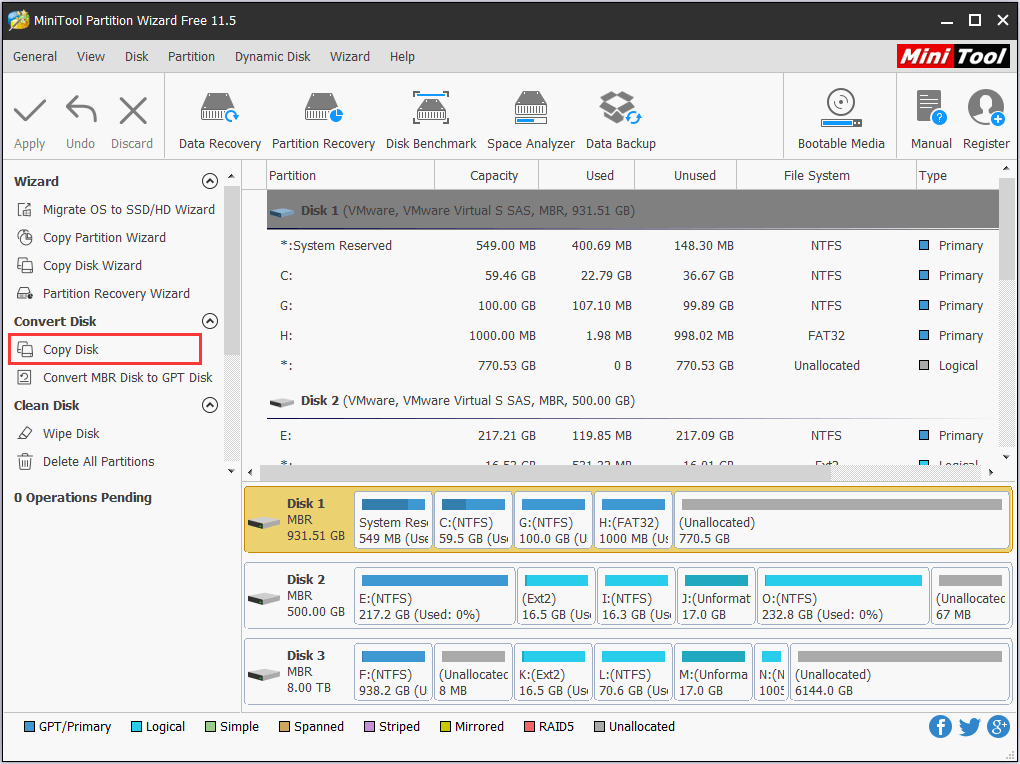
Step 2. On the next interface, select the larger drive as the target disk. Note that all data on the target disk will be cleaned. Click "Next" to continue.
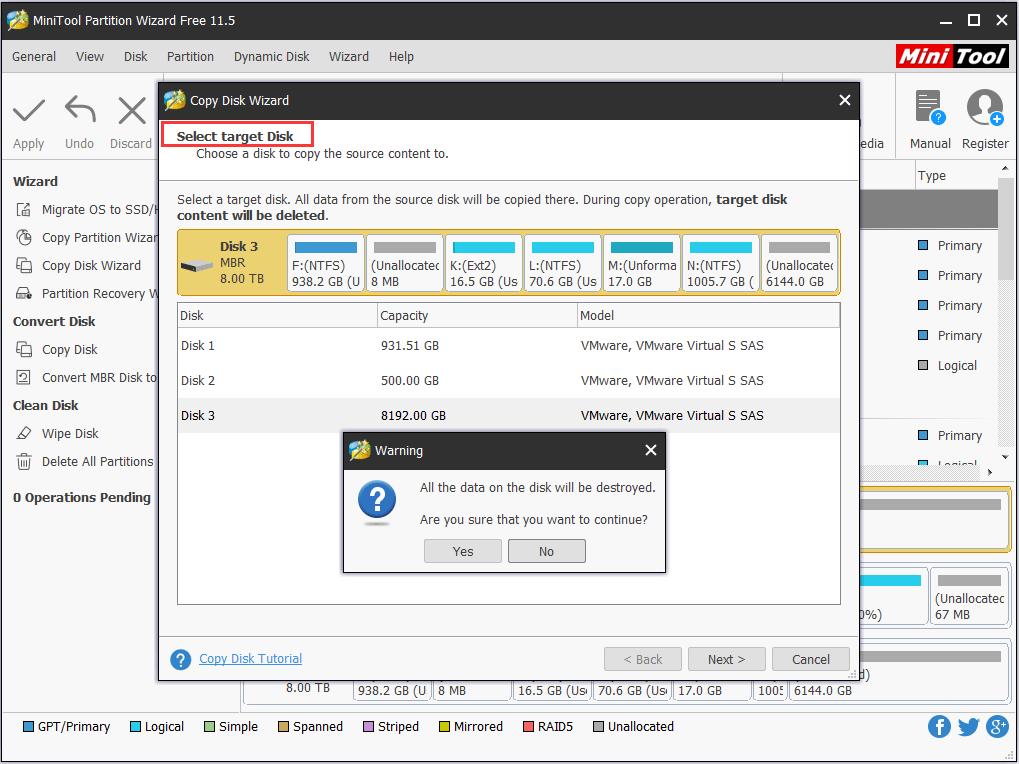
Step 3. Choose the copy options depending on the basis of your preference. It is worth mentioning that no matter you choose "Fit partitions to entire disk" or "Copy Partitions without resize", you can resize each partition by dragging the slider on the lower part.
Note: "Use GUID Partition Table" is a paid feature that helps to clone MBR disk to GPT disk. However, it is available in the Pro and more advanced editions. If you have such requirement, go to the Online Store.
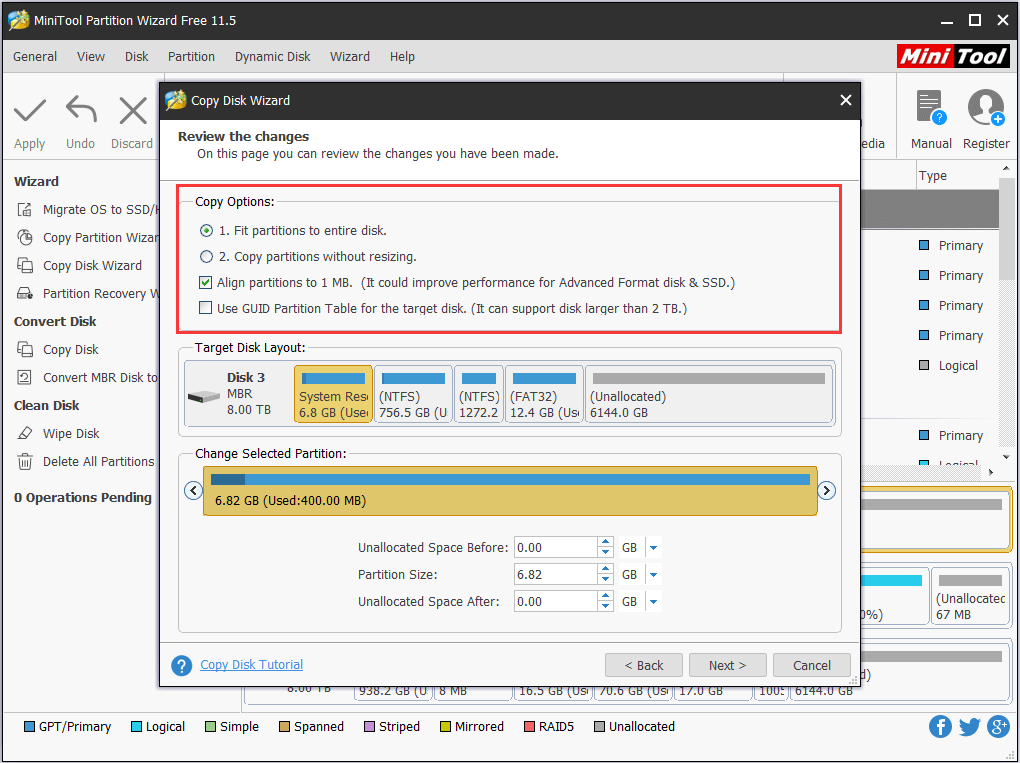
Step 4. Here you will be told how to boot from the destination disk. Please keep this information in mind and click "Finish".
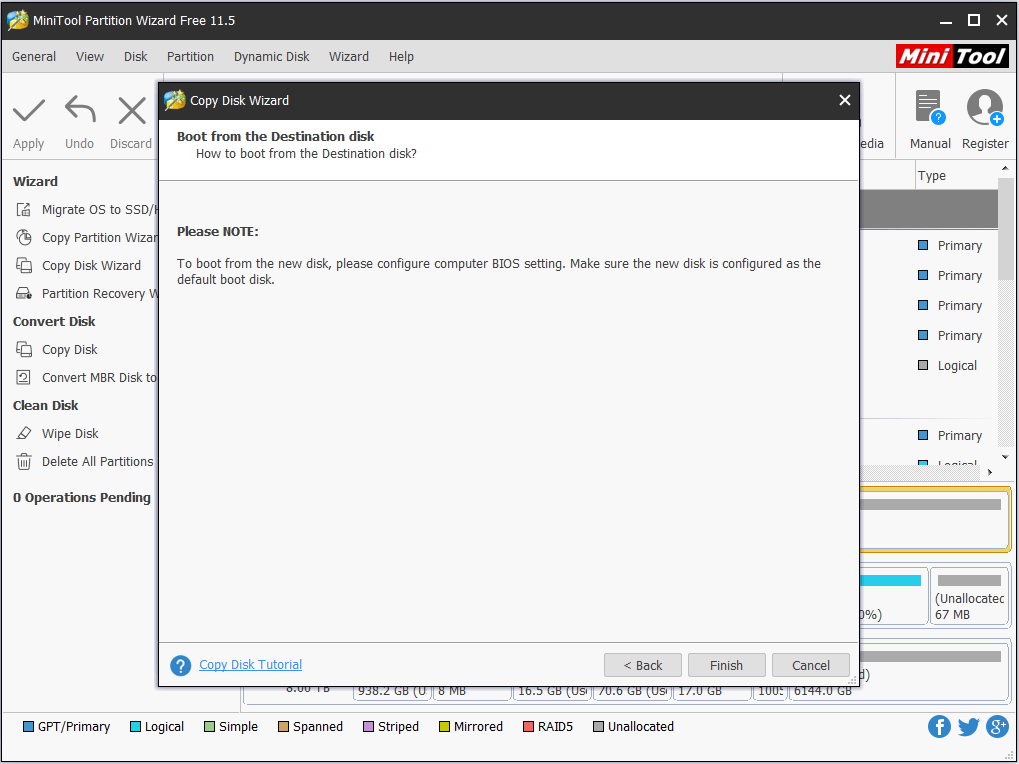
Step 5. Finally, click "Apply" to save the changes.
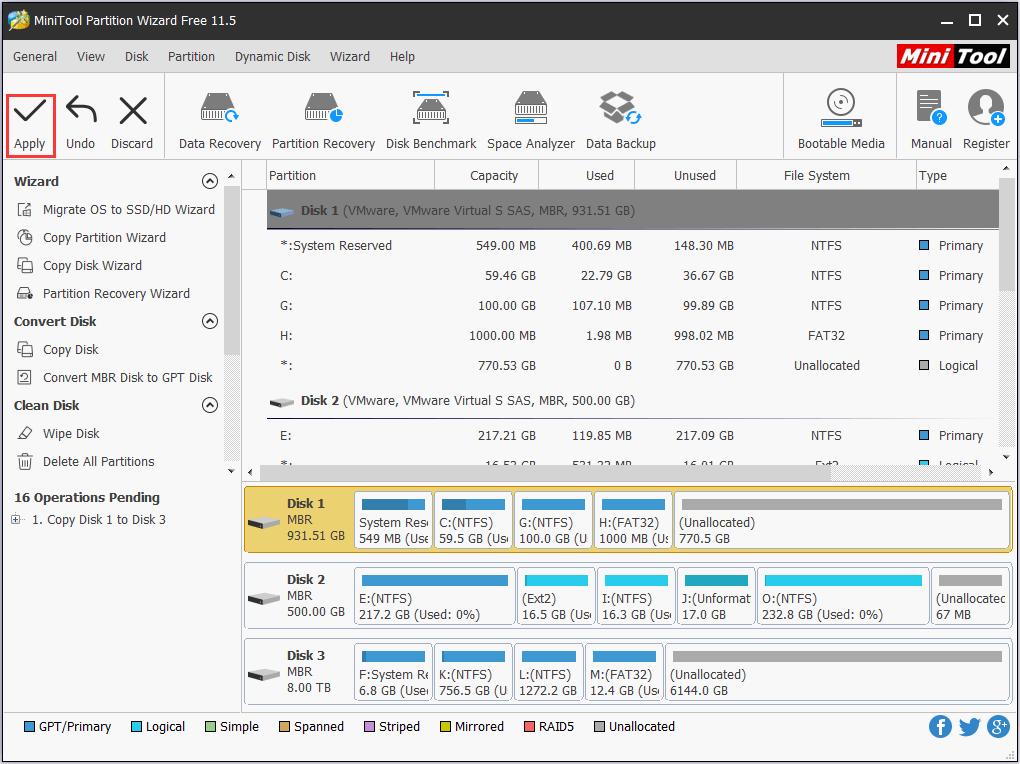
Step 6. Remove the original system disk and boot from the larger hard drive.
Option B: Migrate OS Only
If you only want to move the operating system to a second drive, you can choose "Migrate OS to SSD/HD". This feature is able to clone the OS related partitions like System Reserved Partition, EFI System Partition, System Partition and Recovery Partition.
Step 1. Connect the hard drive to your PC and then run MiniTool Partition Wizard to get the main interface. Select "Migrate OS to SSD/HD" from the toolbar.
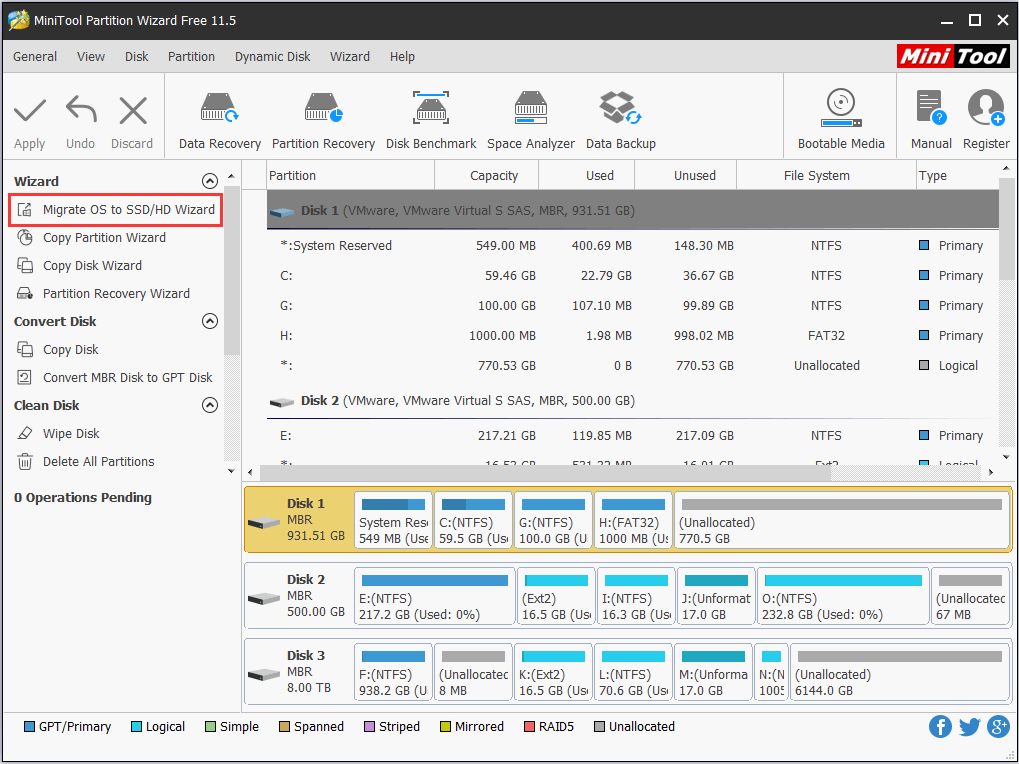
Step 2. In the pop-up window, choose option B, i.e. "I would like to move my operating system to another hard disk."
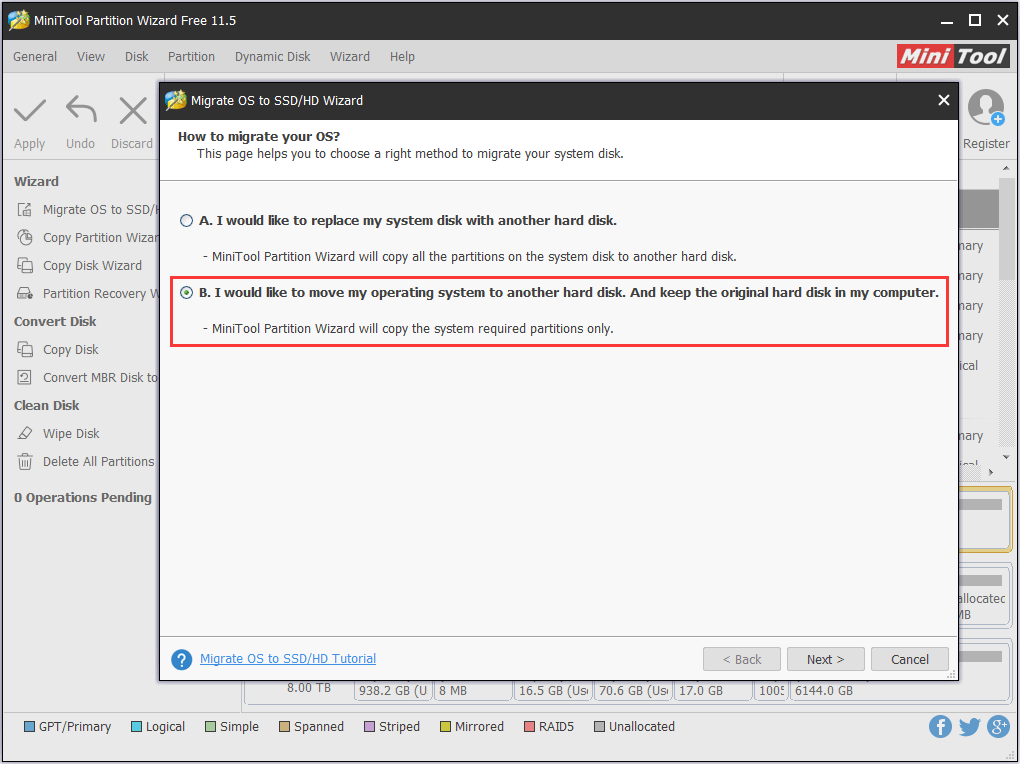
Step 3. Select the target disk. All data on the target disk will be removed.
Step 4. Select the copy options and adjust the partition size.
Step 5. Read the Note carefully and click "Apply" to finish.
Step 6. When the OS is migrated, boot your PC from the larger drive and delete the operating system from the original hard drive.
For the details, please read How Can You Migrate Windows 10 to SSD without Reinstalling OS.
Option C: Copy Some Partitions
You can also choose to move some data partitions to another hard drive, which will free up disk space to the largest extent.
Step 1. Select the partition you want to copy and choose "Copy Partition" from the left action panel.
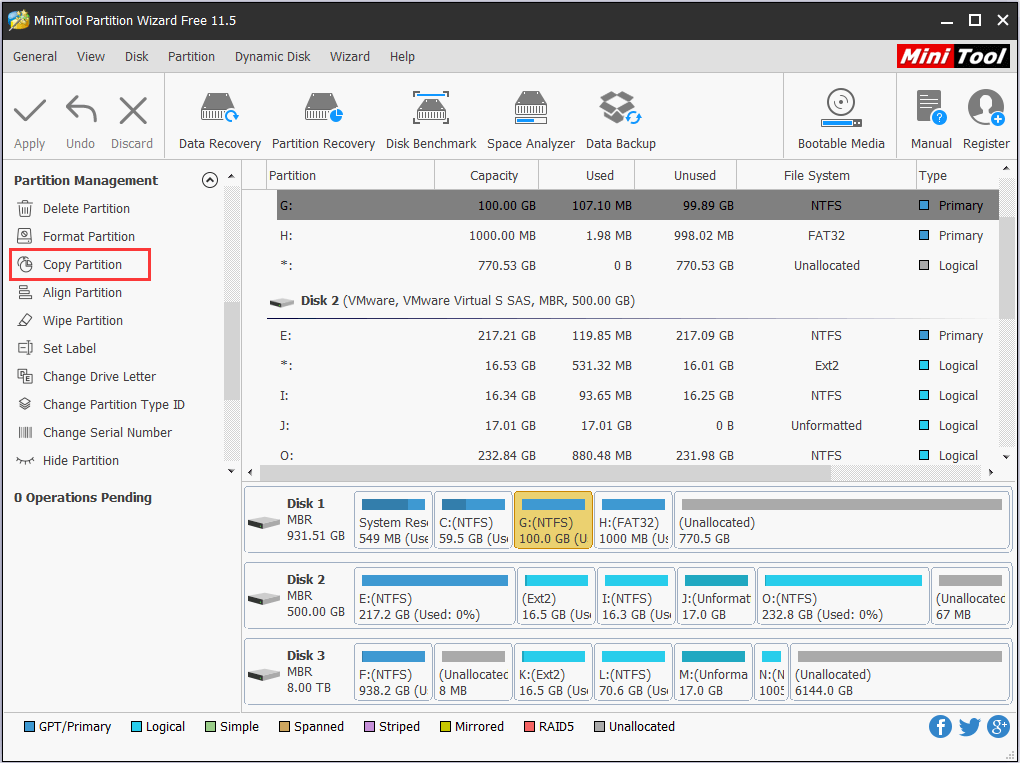
Step 2. Select a location to create the copy of the target partition. Please note that only unallocated space can be selected. Click "Next" to go on.
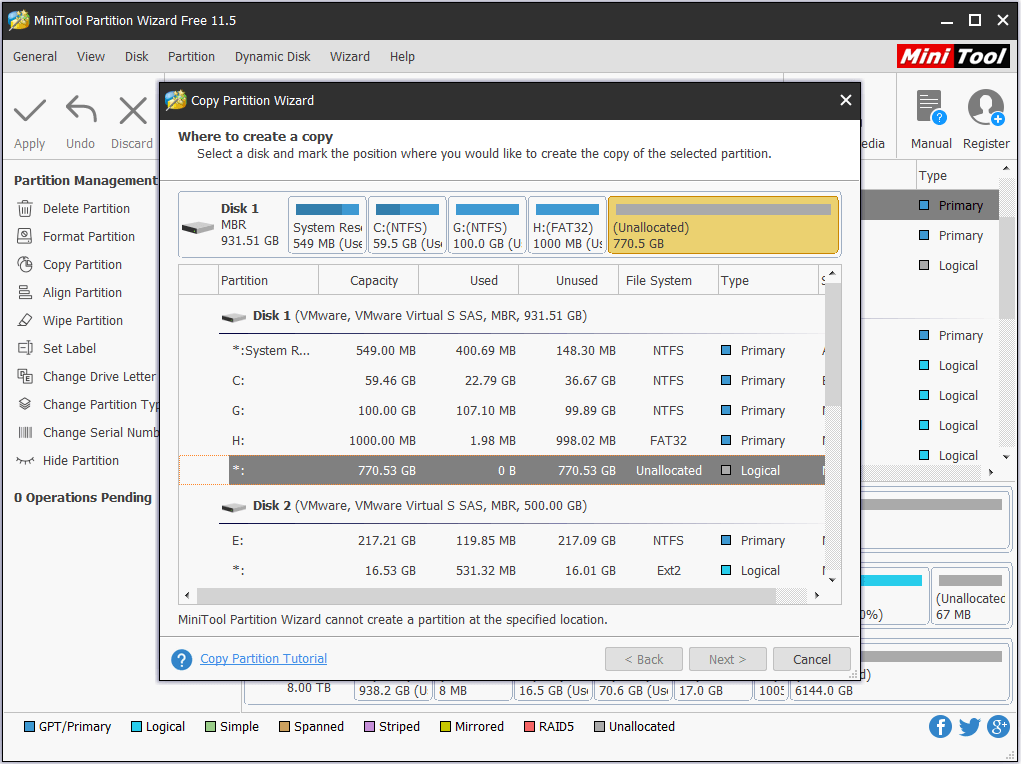
Step 3. Determine the partition size and location. To resize partition, drag the slider bar to shrink or extend. To move the location, drag the partition leftwards or rightwards. Then click "Finish".
Step 4. Click "Apply" to start the copy.
Tip: Now you can delete the partitions that have been copied from the original disk and then make full use of the unallocated space to extend the rest partitions.
"How to clear disk space? These 10 solutions help you carry out Windows disk cleanup easily and effectively." Click to tweet
Now, It's Your Turn
In this post, we show you 10 ways to free up disk space, and hope you never go to the last costly one. If you have come across other workarounds, please list the troubleshooting steps in the comment section below. If you have any questions towards using MiniTool software, you can contact us by sending an email to [email protected].
How To Clear Disk Space In Windows 10
Source: https://www.partitionwizard.com/resizepartition/free-up-disk-space.html
Posted by: carterseethe.blogspot.com

0 Response to "How To Clear Disk Space In Windows 10"
Post a Comment